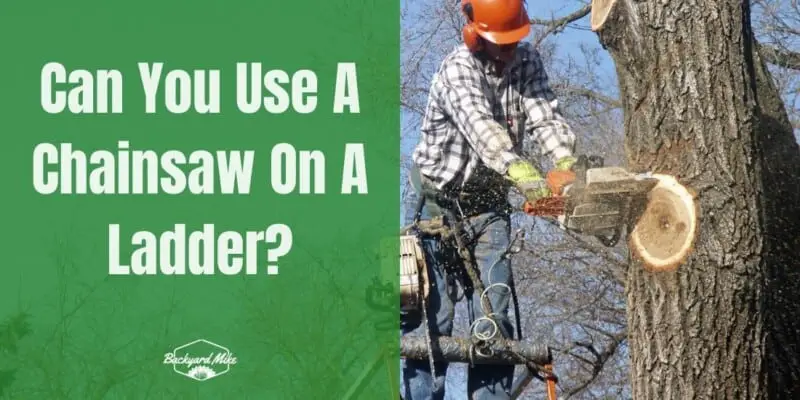Can you use a chainsaw on a ladder? Absolutely!
Is it safe to use a chainsaw on a ladder? Absolutely not!
Although it is dangerous to use a chainsaw on a ladder, it is still possible if you’re taking all the necessary safety measures. In this guide, you’ll get to know all about using a chainsaw on a ladder, the needed safety measures, and possible alternatives for a chainsaw.
Is it safe to use the chainsaw on a ladder?
No, it isn’t. Using a chainsaw on a ladder is far more dangerous than if you’re standing on the ground or on any secure platform. This is the case for a multitude of reasons –
- The ladder could be unstable or fall off the branch that it is leaning against
- The tree branch could be cut too quickly, and it would bend or snap out of control
- The chainsaw operator could lose control of the chainsaw, potentially injuring themselves or someone nearby
- Sometimes, the operator who is looking for balance might try to balance with one hand and cut the tree branch using the other hand on the chainsaw, risking a major injury
Working on an elevated surface should be done with extreme caution and keeping a keen eye on safety. Firstly, it’ll be easier to fall off an elevated surface than many may think. Working on a ladder when cutting a tree branch with pruners or hand saws is one thing, while doing it with a chainsaw will be another. If you’re looking to use a chainsaw on a ladder, you should be sure that you follow all the safety practices (wearing protective equipment, not overreaching, holding the saw at waist level, and more).
Safety measures that you need to consider when using a chainsaw on a ladder
When you’re using a chainsaw on a ladder, it needs to be used with extreme precision and the user has to pay particular attention to it when it is being used. According to statistics by CDC, there are more than 36,000 chainsaw-related injuries that happen in the USA annually. Whether you’re a professional or someone who is using chainsaws in their yard, you should do everything possible to prevent potential accidents. Here are some of the things that you need to know –
- Always use both hands for controlling the chainsaw.
- You should never cut using the chainsaw’s kickback zone or let the saw come into contact with anything other than the branches when the chain is moving.
- Always check for the chain tension before you start using it, if it isn’t right, tighten/loosen it to get the appropriate tension. The chain eventually loosens with use and if it isn’t fixed, it could cause serious injuries.
Note: New chains need to be checked after 20-30 minutes of use, as they stretch quickly at first. Always check the older chains after an hour of usage.
- Remember to wear the relevant protective clothing such as steel top cap bots, eye protection, a hard hat, snug work, safety gloves, and chainsaw safety trousers.
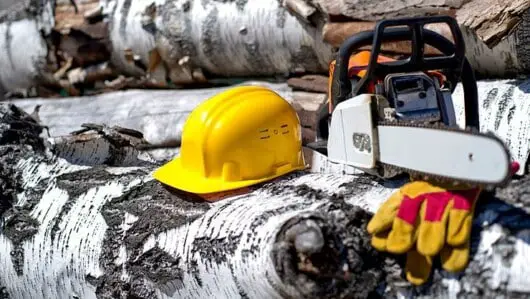
- When you’re not cutting with the chainsaw, always use the chain brake.
- If you’re moving the saw at a short distance, remember to hold it with your hand by the front handle so that you can avoid accidental acceleration. When you’re moving over 10 feet with the chainsaw in hand, remember to turn off the engine.
- You shouldn’t start cutting until you have thought through the path you want to take and all potential scenarios. For instance, if you’re cutting a tree, you should consider the different directions that it could fall in while also ensuring the possible outcomes for safety.
- Move away at least 10 feet from where you’ve added fuel to the chainsaw before you start the engine.
- Only use the chainsaw if the chainsaw is in a good working condition with the safety features intact and having a sharp chain.
Prepare yourself before using a chainsaw
- Grip –Wrap your fingers and thumbs around the handles to have a firm, encircling grip that would prevent a serious accident in the event of potential kickback
- Posture – Having the right posture is essential. You should stand with the feet shoulder-width apart in a study position towards one side of the chainsaw and not directly behind it. Moreover, never squat down or try to overreach when cutting.
- Practice – If you’re a beginner at using a chainsaw, try to get a feel for the balance and power of using the chainsaw by cutting light branches before moving on to a bit more complex tasks.
- Avoid hitting the wrong material – Try to avoid contact with the ground or any other material that might harm your chainsaw. You should remove any nails, wire, or screws from the wood you’re intending to cut before starting.
- Safely power up the chainsaw – If possible, you should use an outdoor extension cord when you’re using power tools. It might seem obvious but a point worth mentioning is that you shouldn’t be standing in a wet area when you’re starting the chainsaw. Finally, you should also keep an eye on how the cables are laid to help you avoid tripping over the cord or cutting the cord.
Alternatives if you don’t want to use a chainsaw on a ladder
Pole saws
Pole saws are essentially saws that are added to an extension pole. There are manual pole saws, electrical pole saws, and even gas-powered chainsaws. These handy tools will help you prune trees at height by simply standing at your feet on the ground. A hand-pruning saw and shears will help you prune most trees, but you’ll have to work from a ladder. Re-positioning the ladder, again and again, could be hard work and for many people, working from a ladder will be downright dangerous.
A pole saw will allow you to round the ladder problem, making light work of pruning and allowing you to see what you’re cutting better.
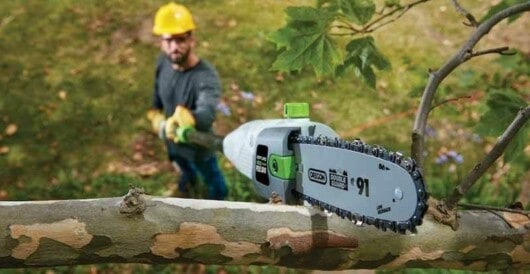
Folding hand-pruning saws
The single most useful tool to prune has to be a folding saw. Some folding saws can be as small as slipping into a pocket and perfect for odd pruning jobs in the garden where you have small plants and trees. Further, they can potentially sport mighty blades that are capable of sawing through large tree trunks. They are incredibly useful for campers and anyone who spends a lot of time in the woodland.
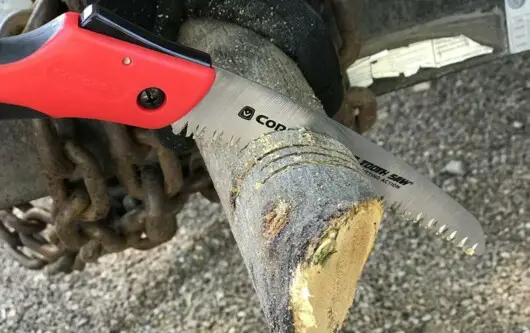
D-Handle saws
A D-Handle pruning saw is a great tool to handle branches up to 8-9 inches in diameter. Most woodworking saws are designed for cutting wood on a bench at a 45-degree angle. A traditional D-Handle pruning saw will work best at more of a 90-degree angle, which makes it ideal for pruning. A curved blade will help you prevent the saw from slipping as you’re working. The modern, ergonomic versions of a D-Handle saw will be easier on the hands but slow to use.
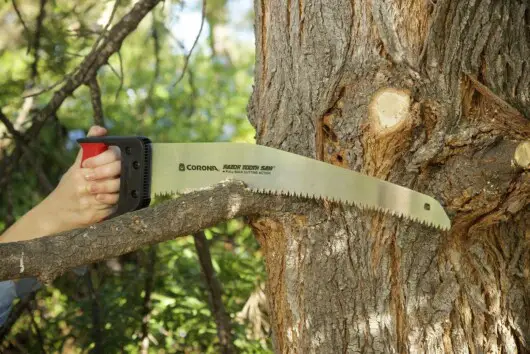
Jawsaws
While Jawsaws aren’t as fast or smooth to use as conventional chainsaws, they’re much safer to use. Kickback isn’t a big problem with jawsaws while you’ll also be well shielded from the smaller chain-driven cutting teeth.
Jawsaws could be used for slicing up fallen timber, cutting live trees, and pruning thick branches up to a few inches across.
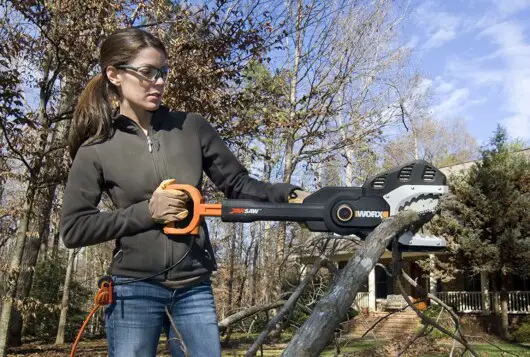
Double-edged pruning saws
A fine-toothed saw will produce incredibly neat cuts with less tearing and bruising of tree tissues, while also reducing the chances of infection after pruning. Having fine teeth on the saw cut slowly and be impractical if you’re working on the branches more than 2-3 inches in diameter, especially if you’re dealing with tough hardwoods.
A double-edged saw will be a highly useful addition to your tool collection. You can easily switch from the fine to the coarse side as needed.
Bow saws
Most full-sized, quality bow saws will help you cut any tree or branch up to a foot in thickness. The teeth in the bow saws are big and splayed out wide. These tools will help you clear plenty of wood as they’re cutting, so the blade doesn’t stick. However, you shouldn’t expect them to cut too straight.
A sharp bow saw and a strong arm will allow you to cut medium-sized, fallen branches far quicker than most power saws. A bow saw is an ideal option if you have a few trees to cut and maintain.
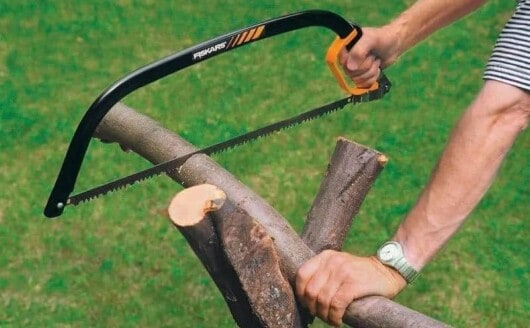
Crosscut saw
Crosscut saws are amazing as they’ll be able to help you cut trees without needing to exert yourself too hard. You can easily place the saw on a tree and rock the saw back and forth to cut down branches and small trees. The rocking motion will be more about the finesse than raw power. Cutting down trees and branches using this tool will be convenient and makes it one of the best manual cutting options that you could consider as an alternative to a chainsaw.
Most crosscut saws are pretty durable. You will make able to use the saw to cut down trees for many years to come. Further, the saw weighs just 3-4 pounds, which means it can be easily used on a ladder. Despite being very light, it is equally rugged and sturdy.
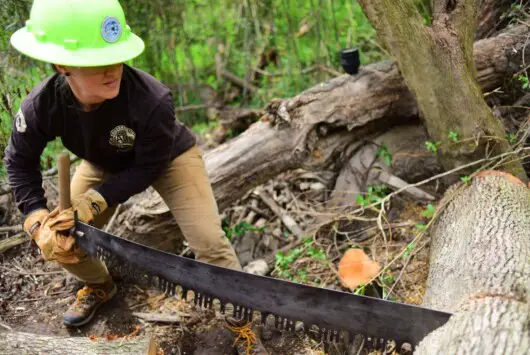
Conclusion
Using a chainsaw on a ladder is an extremely dangerous task, but it can still be done as long as you consider the safety measures needed for using it safely on a ladder. If you must use a ladder, and you’re open to alternatives, there are many alternatives to a chainsaw as mentioned in this guide. Now you have multiple options that you can consider and get on with your cutting or pruning work.

